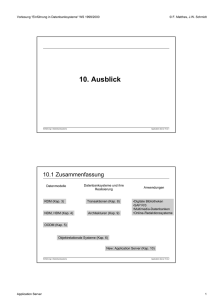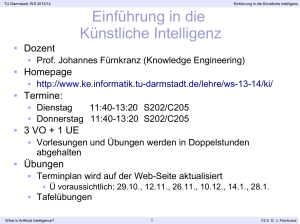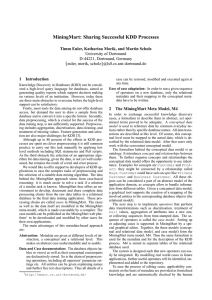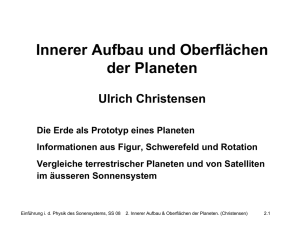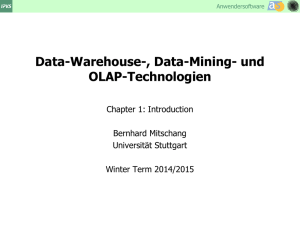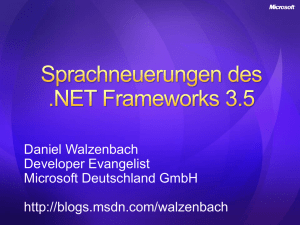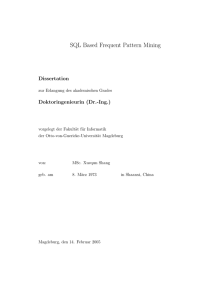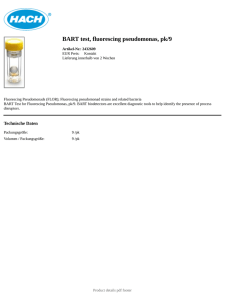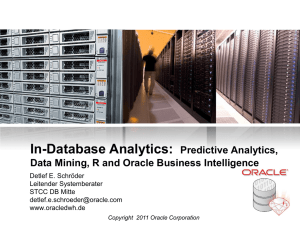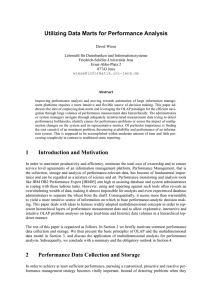Data Mining - Motivation - Knowledge Engineering Group
Werbung
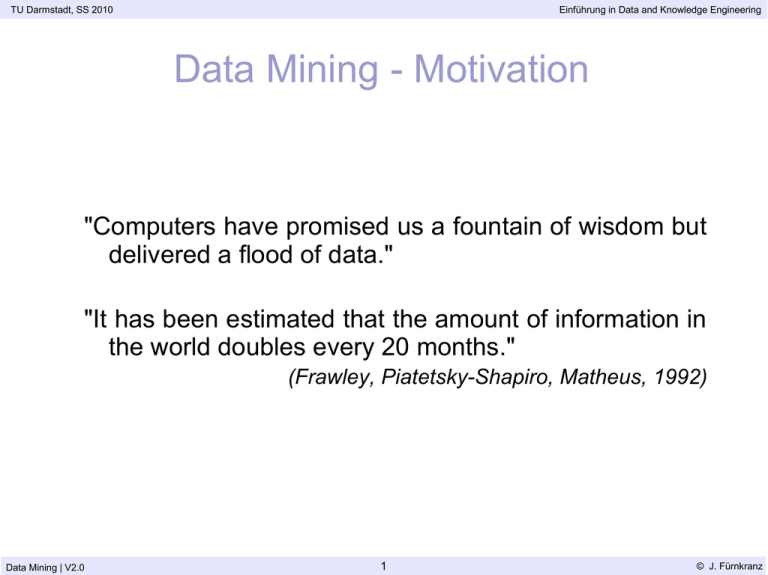
TU Darmstadt, SS 2010 Einführung in Data and Knowledge Engineering Data Mining - Motivation "Computers have promised us a fountain of wisdom but delivered a flood of data." "It has been estimated that the amount of information in the world doubles every 20 months." (Frawley, Piatetsky-Shapiro, Matheus, 1992) Data Mining | V2.0 1 © J. Fürnkranz TU Darmstadt, SS 2010 Einführung in Data and Knowledge Engineering Knowledge Discovery in Databases (KDD) Mining for nuggets of knowledge in mountains of Data. Data Mining | V2.0 2 © J. Fürnkranz TU Darmstadt, SS 2010 Einführung in Data and Knowledge Engineering Daten und Information Daten und Information In Unternehmen sind große Datenmengen vorhanden Daten → Information → Wissen Daten sind ein wichtiger Aktivposten eines Unternehmens Diese Daten enthalten implizit (nicht unmittelbar einsehbar) wertvolle Informationen Beispiel: Jeder Supermarkt speichert Kauftransaktionen ab. Diese Daten enthalten implizit Information Problem: Data Mining | V2.0 welche Produkte gerne gekauft werden welche Produkte gerne zusammen gekauft werden, etc. Wie kann man diese Information explizit machen? 3 © J. Fürnkranz TU Darmstadt, SS 2010 Einführung in Data and Knowledge Engineering Definition Data Mining is a non-trivial process of identifying It employs techniques from valid novel potentially useful ultimately understandable machine learning statistics databases patterns in data. (Fayyad et al. 1996) Or maybe: Data Mining is torturing your database until it confesses. (Mannila (?)) Data Mining | V2.0 4 © J. Fürnkranz TU Darmstadt, SS 2010 Einführung in Data and Knowledge Engineering World-Wide Data Growth Science Business Data Mining | V2.0 OLTP (on-line transaction processing) data warehouses e-commerce Industry satellite monitoring human genome process data World-Wide Web 5 © J. Fürnkranz TU Darmstadt, SS 2010 Einführung in Data and Knowledge Engineering OLTP vs. OLAP On-line Transaction Processing (OLTP) Data Warehouse Goal: support order processing and billing typically multiple, isolated relational databases even simple queries like ''How many items of product X do we sell?'' may be hard to answer uniform view to multiple separate data sources fast access across a multitude of dimensions (data cube) no need for update in real time On-line Analytical Processing (OLAP) Data Mining | V2.0 Goal: support decision makers allow complex, multi-dimensional queries 6 © J. Fürnkranz TU Darmstadt, SS 2010 Einführung in Data and Knowledge Engineering TV PC VCR sum 1Qtr 2Qtr Date 3Qtr 4Qtr sum Total annual sales of TV in U.S.A. U.S.A Canada Mexico Country Pr od uc t Data Cube sum Taken from Han & Kamber, 2001 Data Mining | V2.0 7 © J. Fürnkranz TU Darmstadt, SS 2010 Einführung in Data and Knowledge Engineering Data Cube Aggregation mehrerer interessanter Dimension in eine effiziente Datenstruktur z.B. Produkte x Zeit x Region kann man sich als eine multi-dimensionale Erweiterung von Spread-sheets vorstellen Aggregierte Summen werden oft vorberechnet Data Mining | V2.0 z.B. für hierarchische Attributwerte 8 Abbildung von Prof. E. Rahm © J. Fürnkranz TU Darmstadt, SS 2010 Einführung in Data and Knowledge Engineering Typische Operationen auf einem Data Cube Slice: Dice: Herausschneiden einer Scheibe aus dem Datacube (Selektion nach einem Wert) Herausschneiden eines Teilwürfels (Selektion nach mehreren Werten und Dimensionen) Roll-Up: Aufwärtsbewegung in den hierarchischen Attributen Aggregation der Daten entlang des Pfades Drill-Down: e.g., Monat → Quartal → Jahr Abwärtsbewegung in den hierarchischen Attributen Pivotierung / Rotation: Data Mining | V2.0 Drehen des Würfels, sodaß eine andere Dimension sichtbar wird 9 Abbildungen von Prof. E. Rahm © J. Fürnkranz TU Darmstadt, SS 2010 Einführung in Data and Knowledge Engineering OLAP vs. Data Mining Verification Model the user needs to verify a hypothesis on the data formulates the query and poses it to the OLAP system Example: Break up sales according to products in the U.S. Break up sales according to products in Canada Any significant difference? Discovery Model the system can autonomously propose interesting and novel hypotheses (and verify them on the data) the user formulates the problem Example: Data Mining | V2.0 Can you find any patterns involving regions, date, products for which the sales differ significantly from the average? 10 © J. Fürnkranz TU Darmstadt, SS 2010 Einführung in Data and Knowledge Engineering Inductive Databases (Mannila & Iemielinski, CACM-96) make patterns queryable in the database Examples: SQL is a query language that generates data sets inductive database should have a language that (also) generates pattern sets ''show me all association rules with support > 1% and a minimum confidence > 95% that have salary in the head'' ''show me decision trees with estimated accuracy > 90% that are built on at most 5 of the following 7 attributes'' often an SQL-like Syntax is used for this purpose Data Mining | V2.0 11 © J. Fürnkranz TU Darmstadt, SS 2010 Einführung in Data and Knowledge Engineering Knowledge Discovery in Databases: Key Steps Key steps in the Knowledge Discovery cycle: 1. Data Cleaning: remove noise and incosistent data 2. Data Integration: combine multiple data sources 3. Data Selection: select the part of the data that are relevant for the problem 4. Data Transformation: transform the data into a suitable format (e.g., a single table, by summary or aggregation operations) 5. Data Mining: apply machine learning and machine discovery techniques 6. Pattern Evaluation: evaluate whether the found patterns meet the requirements (e.g., interestingness) 7. Knowledge Presentation: present the mined knowledge to the user (e.g., visualization) Data Mining | V2.0 12 © J. Fürnkranz TU Darmstadt, SS 2010 Einführung in Data and Knowledge Engineering Data Mining is a Process ! The steps are not followed linearly, but in an iterative process. Source: http://alg.ncsa.uiuc.edu/tools/docs/d2k/manual/dataMining.html, after Fayyad, Piatetsky-Shapiro, Smyth, 1996 Data Mining | V2.0 13 © J. Fürnkranz TU Darmstadt, SS 2010 Einführung in Data and Knowledge Engineering Another Process Model Source: http://www.crisp-dm.org/ Data Mining | V2.0 14 © J. Fürnkranz TU Darmstadt, SS 2010 Einführung in Data and Knowledge Engineering Research Issues Techniques for mining different types of knowledge Interactive Data Mining Techniques Data are typically not neat and tidy, but noisy and messy. Pattern Evaluation Data Mining | V2.0 How to explain the results to the CEO? Handling Noisy or Incomplete Data Querying patterns instead of querying database entries Presentation and Visualization of Results Knowledge about the task helps. Data Mining Query Languages A Human/Computer Team may be more efficient Incorporation of Background Knowledge Predictions, Associations, Clusters, Outliers, ... How can we define interestingness? 15 © J. Fürnkranz TU Darmstadt, SS 2010 Einführung in Data and Knowledge Engineering (A few) Data Mining Applications Business predict credit rating identify customer groups direct marketing market basket analysis recommender systems fraud detection Web Mining categorize Web pages (web catalogues) classify E-mail (spam filters) identify Web usage patterns Data Mining | V2.0 16 Quality control learn to assess quality of products Biological/Chemical discover toxicological properties of chemicals Game Playing identify common (winning) patterns in game databases .... © J. Fürnkranz TU Darmstadt, SS 2010 Einführung in Data and Knowledge Engineering Literatur Artikel Tomasz Imielinski, Heikki Mannila: A database perspective on knowledge discovery, Communications of the ACM, 39(11):58-64, 1996. (On Inductive Databases) Bücher Data Mining | V2.0 Jiawei Han and Micheline Kamber: Data Mining – Concepts and Techniques, Academic Press, 2001. (datenbankorientierte Einführung) 17 © J. Fürnkranz
